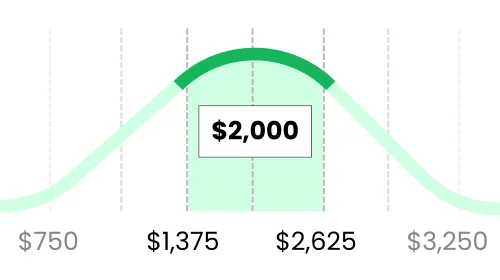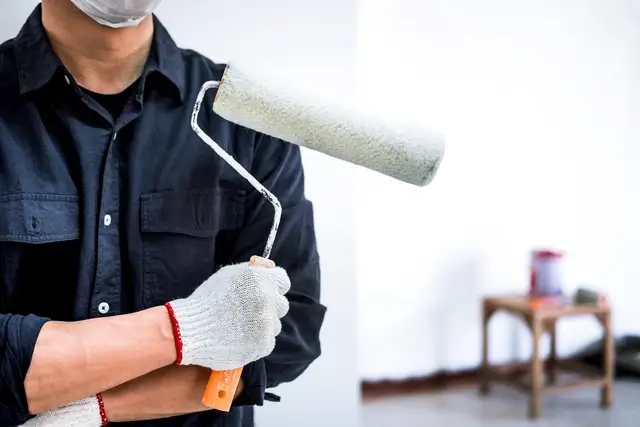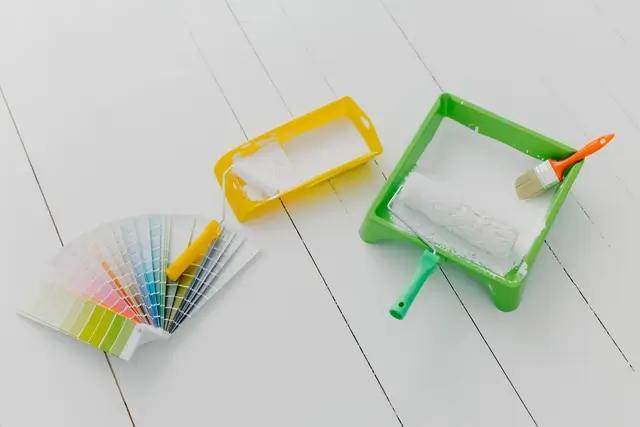$2,000
National average fixed price

Looking for an accurate quote for your location?

Discover how we calculate average interior painting costs and select top-rated providers, ensuring you get the most accurate and reliable estimates.
Home » Cost Calculators » Interior Painting Cost
Whether you’re looking to brighten up your living space, give your home a modern update, or simply cover up years of wear and tear, painting the interior of your house is one of the most effective ways to transform a room. But how much does interior painting really cost? In this guide, we’ll break down the factors that affect the cost, provide average pricing, and offer some tips on how to get the most bang for your buck.

Before we dive into the costs, let’s talk about why interior painting is a worthwhile investment. Fresh paint not only enhances the aesthetic appeal of your home, but it also protects your walls from damage, increases your home’s value, and can even improve your mood.
I remember when we decided to repaint our living room after years of putting it off. We chose a soft, warm color that completely changed the feel of the space—it felt like a brand new room! The fresh coat of paint also covered up years of scuffs and minor dings, making the room look clean and well-maintained.
The cost of interior painting can vary significantly based on several factors. Here’s what you need to consider:
One of the biggest factors affecting the cost is the size of the area being painted. Most painters charge by square footage, so the larger the space, the higher the cost. For instance, painting a single room will cost much less than painting an entire home.
The type of paint you choose also has a significant impact on the overall cost. High-quality paints generally cost more upfront, but they often last longer and provide better coverage, which can save you money in the long run.

3. Labor Costs
Labor is typically the most significant portion of the painting cost. The complexity of the job, the number of coats needed, and the time required to prep the space (such as moving furniture, repairing walls, or taping off areas) can all affect labor costs.
If your walls are in good condition, the job will be quicker and less expensive. However, if your walls have holes, cracks, or water damage, they’ll need to be repaired before painting, which adds to the cost. I’ve learned from experience that it’s worth investing in wall repairs before painting—skipping this step can result in a less polished finish and may require touch-ups sooner than expected.
The number of coats required depends on the current color of your walls and the new color you’ve chosen. Darker colors may need more coats to achieve full coverage, and certain finishes, like glossy or semi-gloss, can also affect the price.
So, what should you expect to pay for interior painting? While costs can vary based on the factors mentioned above, here’s a general idea:
For a typical 12×12 room, the cost might range from $300 to $800. This includes labor, paint, and supplies. Larger rooms or rooms with high ceilings will cost more.
If you’re painting multiple rooms or the entire house, painters often charge by the square foot. On average, expect to pay $2 to $6 per square foot. This includes both the walls and the ceiling, but not trim or doors.
Painting the entire interior of a home typically costs between $2,000 and $8,000. For a larger home, especially one with intricate details or higher-end finishes, the price can go even higher.

Painting your home’s interior doesn’t have to break the bank. Here are some tips to help you save money:
You can reduce labor costs by doing some of the prep work yourself, such as moving furniture, covering floors, and even taping off areas. Just be sure to ask your painter if they’re okay with this—some prefer to handle the prep themselves to ensure it’s done correctly.
Painters are often busiest in the warmer months. If possible, schedule your painting job during the off-season (fall or winter) when demand is lower—this could lead to better pricing.
Always get at least three quotes from different painters. This not only helps you compare prices but also gives you a sense of the market rate in your area. Don’t automatically go with the lowest bid—consider the painter’s reputation, experience, and the quality of their work.
If you’re just painting a single room or a small space, doing it yourself can save a significant amount of money. Just be sure you’re comfortable with the work involved and have the right tools and materials.



When it comes to choosing a painter, it’s important to do your research. Here are a few things to keep in mind:
Make sure the painter is licensed and insured. This protects you in case of any accidents or damage during the job. In my experience, checking credentials upfront can save a lot of headaches down the road.
Ask to see examples of their previous work. A good painter should have a portfolio of past projects that demonstrates their skill and attention to detail.
Online reviews can provide valuable insights into a painter’s reliability, quality of work, and customer service. Take the time to read through reviews on platforms like Google, Yelp, or Angie’s List.
Some painters offer warranties on their work, which can provide peace of mind. Be sure to ask what the warranty covers and how long it lasts.
Before painting, remove switch plates and outlet covers yourself to save on labor costs and ensure a cleaner, more professional finish.
Absolutely. Interior painting is one of the most cost-effective ways to refresh your home and increase its value. Whether you’re looking to update your space with a new color scheme or simply freshen up the walls, the investment is well worth it.
From my own experience, I can say that a fresh coat of paint can completely transform a room. It not only makes your home look better but also makes it feel better. And when you choose the right painter and the right paint, the results can last for years.
So, if you’re considering painting the interior of your home, now might be the perfect time to get started. Just remember to budget for the costs, do your research, and don’t be afraid to invest in quality work—it’s an investment in your home’s future.
The cost to paint the interior of a house typically ranges from $2 to $6 per square foot. For a single room, you can expect to pay between $300 and $800, while painting an entire home can range from $2,000 to $8,000 or more, depending on factors like the size of the space, the type of paint used, and labor costs.
Most experts recommend repainting your home’s interior every 5 to 7 years. However, high-traffic areas like hallways, kitchens, and bathrooms may need to be repainted more frequently due to wear and tear.
While you can paint the interior of your home at any time of year, the fall and winter months are often the best time. Painters tend to be less busy during these seasons, which can lead to better availability and possibly lower prices. Plus, the lower humidity during these months can help the paint dry more evenly.
Yes, you can stay in your house while it’s being painted, but it may require some adjustments. Painters typically work room by room, so you can plan to use other parts of your home while one area is being painted. Be mindful of paint fumes, and ensure proper ventilation by opening windows and using fans.
Choosing the right paint color can be challenging. Consider the room’s purpose, the amount of natural light, and the existing decor. It’s also a good idea to test a few samples on your walls and observe how the colors look at different times of the day before making a final decision.
The time it takes to paint a room depends on its size, the number of coats required, and the amount of prep work needed. On average, painting a standard 12×12 room might take 6 to 8 hours for a professional, including setup, painting, and cleanup.
Yes, it’s best to remove as much furniture as possible from the room before painting. This protects your belongings from paint splatters and gives the painters more space to work. If removing all the furniture isn’t possible, move it to the center of the room and cover it with drop cloths.
Priming is recommended, especially if you’re making a significant color change, painting over stains, or working with new drywall. Primer helps the paint adhere better and ensures a more even and long-lasting finish.
While it’s possible to paint over wallpaper, it’s generally better to remove it first. Painting over wallpaper can lead to peeling or bubbling, and it may not give you the smooth finish you’re looking for. If removal isn’t an option, make sure to repair any loose edges and apply a primer before painting.
No results available
Reset© 2024 All Rights Reserved
Thank you! We’ve received your request and are working on finding you the best deals in your area. We’ll connect you with top-rated local businesses shortly!